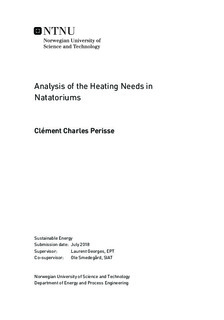Analysis of the Heating Needs in Natatoriums
Master thesis
Permanent lenke
http://hdl.handle.net/11250/2566512Utgivelsesdato
2018Metadata
Vis full innførselSamlinger
Sammendrag
In the quest of improving energy performance in buildings, swimming facilities stand out due to their excessive consumption. When it comes to scientific research, few publications have addressed this type of facility compared to residential or commercial buildings. The specificity of natatoriums is due to complex processes that challenge indoor environment, building structure maintenance, and energy use in a great extent. Energy saving potential becomes all the more important as these processes are highly consuming and appear not to be optimally tackled. Large discrepancies in energy consumption exist among swimming facilities, and W. Kampel estimated the final annual energy consumption could be lowered by 28% in total in Norway.This study aims at analyzing energy use and power demand in natatoriums. Two models were built utilising the building performance simulation tool, IDA-ICE, along with the Ice Rinks & pool extension. The consumption per square meter of water surface within the model was slightly above the Norwegian statistical average of 4000 kWh/m_ws^2. The analysis brought a deeper understanding about both the software code related to the pool and the heating needs of swimming facility. Energy need due to evaporation appeared to be equivalent to the space-heating needs and even showed to have higher power peak values.Sensitivity analysis were run to investigate influences of key parameters. Four parameters stood out: the pool temperature set-point, the pool area, the n_50 infiltration coefficient, and the pool activity factor. Further analysis focused on the effect these parameters have on the system s behavior. Studies were conducted to explore whether a parameter triggers higher power demand from the air-handling unit or increased loss through the structure, or higher evaporation rate leading to higher energy demand for heating of the pool water.Finally, a comparison with the practical case of a swimming pool at Jøa was established thanks to data retrieved from sensors and energy meters set up there. The use of an integrated heat pump in the air-handling unit at Jøa can be misleading and then only domestic hot water consumption and thermal energy released to the pool are comparable. Both seem to be much higher in the IDA-ICE models. Due to short time framing and high complexity, a model gathering all specific features from Jøa still need to be built and further investigations are required.
